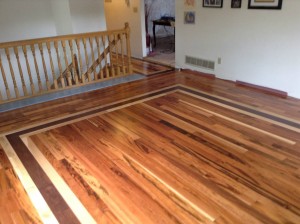Your wood flooring was delivered last week and your installer is scheduled to come over tomorrow morning to install your hardwood flooring. What seemed so intuitive at the store now seems overwhelming with the decision you must make on which direction to install your hardwood flooring. After all, this might be a decision you will have to live with for a long time. Luckily, we are here to help you make the correct decision.
The direction in which you install hardwood flooring boards is dictated by several factors which we will cover in this segment. Factors such as visual aesthetics, structural integrity, and the installation method should all be considered when installing your new hardwood flooring.
Consider the Subfloor
The first factor we must consider is the subfloor and method of installation. If the subfloor is concrete, structural considerations for direction will have little effect on the performance of your flooring. However, if we install with the more standard nail down method over plywood, the direction of the floor joist must be taken into consideration. The general rule of thumb is to install perpendicular to the floor joist, doing so will allow the flooring to keep its structural integrity if the joists sag. Exceptions can be made with the use of additional subfloor use to strengthen the existing subfloor.
 The best way to show off those visually stunning planks may not be so clear-cut. Interior designers often agree it is preferred to run your hardwood flooring straight in from the front entry. This gives visitors a sense of openness flowing into your home. Hallways should aim to have planks running in the same direction. Directional changes should be avoided to give the flooring a more continuous flow. However, these are best used to designate a special area such as a dining room or study. When it comes to aesthetics, these are only general guidelines as each home should have its own unique feel. One might even consider an angled installation to better fit the layout.
The best way to show off those visually stunning planks may not be so clear-cut. Interior designers often agree it is preferred to run your hardwood flooring straight in from the front entry. This gives visitors a sense of openness flowing into your home. Hallways should aim to have planks running in the same direction. Directional changes should be avoided to give the flooring a more continuous flow. However, these are best used to designate a special area such as a dining room or study. When it comes to aesthetics, these are only general guidelines as each home should have its own unique feel. One might even consider an angled installation to better fit the layout.
Just remember to let your installer know before they start. When in doubt, install perpendicular to the joist. You may want to consult the manufacturer of your flooring or your floor store to ensure you are following their guidelines to keep the warranty intact. If you have specific questions, let us know.

